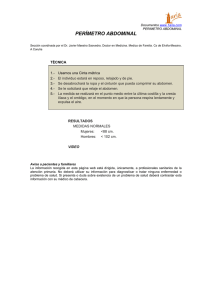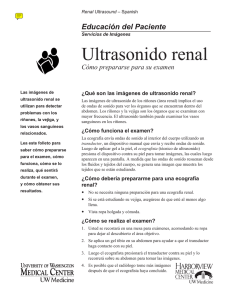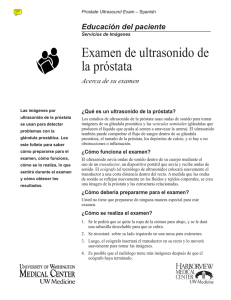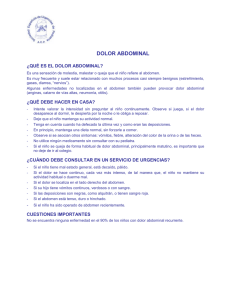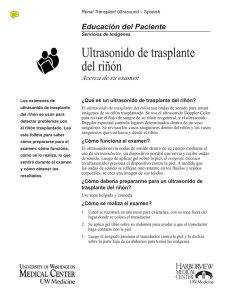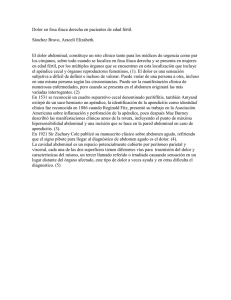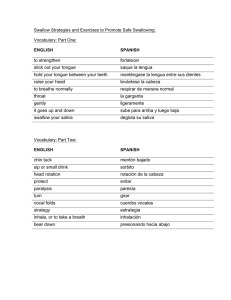Ultrasonido abdominal - Health Online
Anuncio
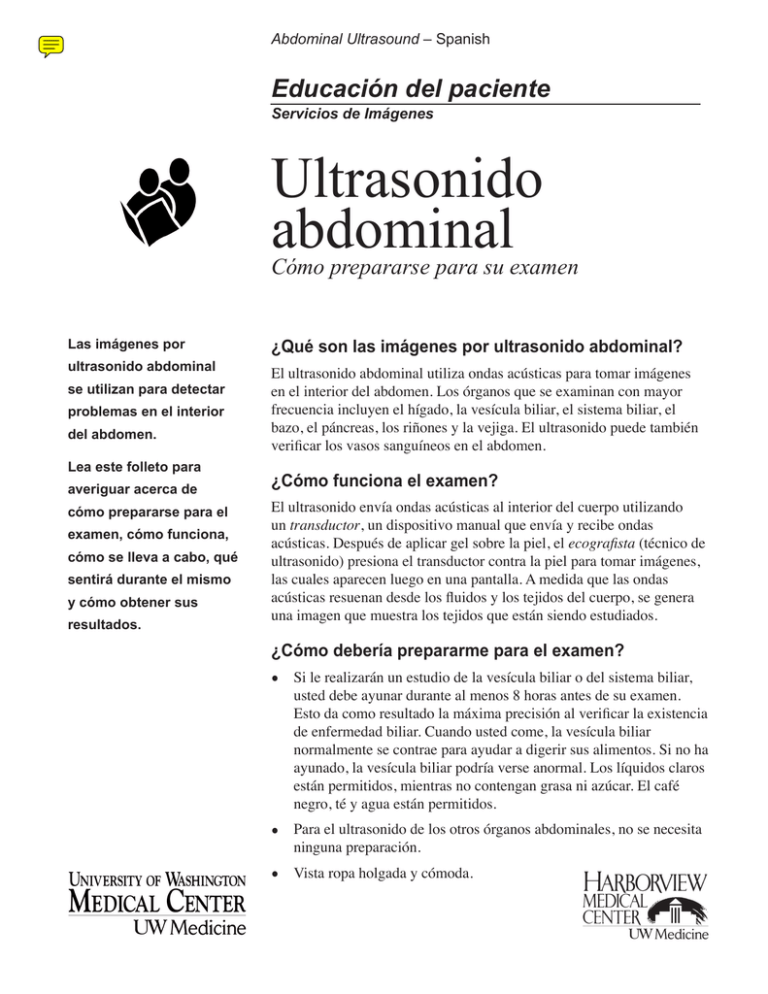
Abdominal Ultrasound – Spanish Educación del paciente Servicios de Imágenes Ultrasonido abdominal Cómo prepararse para su examen Las imágenes por ultrasonido abdominal se utilizan para detectar problemas en el interior del abdomen. Lea este folleto para averiguar acerca de cómo prepararse para el examen, cómo funciona, cómo se lleva a cabo, qué sentirá durante el mismo y cómo obtener sus resultados. ¿Qué son las imágenes por ultrasonido abdominal? El ultrasonido abdominal utiliza ondas acústicas para tomar imágenes en el interior del abdomen. Los órganos que se examinan con mayor frecuencia incluyen el hígado, la vesícula biliar, el sistema biliar, el bazo, el páncreas, los riñones y la vejiga. El ultrasonido puede también verificar los vasos sanguíneos en el abdomen. ¿Cómo funciona el examen? El ultrasonido envía ondas acústicas al interior del cuerpo utilizando un transductor, un dispositivo manual que envía y recibe ondas acústicas. Después de aplicar gel sobre la piel, el ecografista (técnico de ultrasonido) presiona el transductor contra la piel para tomar imágenes, las cuales aparecen luego en una pantalla. A medida que las ondas acústicas resuenan desde los fluidos y los tejidos del cuerpo, se genera una imagen que muestra los tejidos que están siendo estudiados. ¿Cómo debería prepararme para el examen? • Si le realizarán un estudio de la vesícula biliar o del sistema biliar, usted debe ayunar durante al menos 8 horas antes de su examen. Esto da como resultado la máxima precisión al verificar la existencia de enfermedad biliar. Cuando usted come, la vesícula biliar normalmente se contrae para ayudar a digerir sus alimentos. Si no ha ayunado, la vesícula biliar podría verse anormal. Los líquidos claros están permitidos, mientras no contengan grasa ni azúcar. El café negro, té y agua están permitidos. • Para el ultrasonido de los otros órganos abdominales, no se necesita ninguna preparación. • Vista ropa holgada y cómoda. Servicios de Imágenes Ultrasonido abdominal ¿Preguntas? Sus preguntas son importantes. Si tiene preguntas o inquietudes, llame a su médico o proveedor de atención a la salud. El personal de la clínica también se encuentra disponible para ayudar. q Servicio de Imágenes de UWMC: 206-598-6200 q Servicios de Imágenes de Harborview: 206-744-3105 ¿Cómo se realiza el examen? 1. Usted se recostará sobre una mesa de examen, habiendo acomodado su ropa para dejar su abdomen descubierto. 2. Se aplicará un gel tibio a su abdomen para ayudar a que el transductor haga contacto con su piel. 3. El ecografista luego presionará el transductor contra su piel y lo moverá de un lado a otro para obtener todas las imágenes. 4. Es posible que el radiólogo tome más imágenes una vez que el ecografista haya concluido. ¿Qué sentiré durante el examen? • • El ultrasonido del abdomen es rápido, indoloro y fácil. • El transductor se desplazará sobre su piel hasta que se obtengan todas las imágenes. • Es posible que se le pida que se recueste sobre uno de sus lados, o que cambie de posición. • Hay muy poca o ninguna incomodidad. El examen normalmente dura menos de 45 minutos. Sentirá que el ecografista aplica gel tibio en su abdomen y presiona el transductor contra su piel. ¿Quién interpreta los resultados del examen y cómo los obtengo? El radiólogo que se especializa en ultrasonido revisará las imágenes y enviará el informe a su médico referente. Usted recibirá sus resultados del médico que ordenó el examen. El radiólogo podría conversar con usted acerca de los resultados iniciales al concluir su examen. UWMC Imaging Services Box 357115 1959 N.E. Pacific St. Seattle, WA 98195 206-598-6200 © University of Washington Medical Center Abdominal Ultrasound Spanish 03/2005 Rev. 05/2009 Reprints: Health Online Patient Education Imaging Services Abdominal Ultrasound How to prepare for your exam Abdominal ultrasound What is abdominal ultrasound imaging? imaging is used to detect abdomen. Ultrasound of the abdomen uses sound waves to take pictures inside of the abdomen. The organs examined most often include the liver, gallbladder, biliary system, spleen, pancreas, kidneys, and bladder. Ultrasound can also check the blood vessels in the abdomen. Read this handout to learn How does the exam work? how to prepare for the Ultrasound sends sound waves into the body using a transducer, a hand-held device that sends and receives sound waves. After gel is applied to the skin, the sonographer (ultrasound technologist) presses the transducer against the skin to take pictures, which then appear on a screen. As the sound waves echo from the body’s fluids and tissues, a picture is created showing the tissues that are being studied. problems inside the exam, how it works, how it is done, what you will feel during the exam, and how to get your results. How should I prepare for the exam? • If the gallbladder or biliary system will be studied, you must fast for at least 8 hours before your exam. This results in the highest accuracy in checking for biliary disease. When you eat, the gallbladder normally contracts to help digest your food. If you haven’t fasted, the gallbladder may look abnormal. Clear liquids are fine, as long as there is no fat or sugar. Black coffee, tea, and water are fine. • For ultrasound of the other abdominal organs, no preparation is needed. • Wear loose-fitting, comfortable clothing. Imaging Services Abdominal Ultrasound How is the exam done? Questions? Your questions are important. Call your doctor or health care provider if you have questions or concerns. Clinic staff are also available to help. UWMC Imaging Services: 206-598-6200 1. You will lie on an exam table, with your clothing moved away from your abdomen. 2. A warm gel is applied to your abdomen to help the transducer make contact with your skin. 3. The sonographer then presses the transducer against your skin and moves it around to obtain all the pictures. 4. The radiologist may take more pictures after the sonographer is done. What will I feel during the exam? • Ultrasound of the abdomen is fast, painless, and easy. • You will feel the sonographer apply warm gel to your abdomen, and press the transducer against your skin. • The transducer will be moved over your skin until all the pictures are obtained. __________________ • You may be asked to roll on either side, or change your position. __________________ • There is little or no discomfort. The exam usually takes less than 45 minutes. Harborview Imaging Services: 206-744-3105 __________________ __________________ Who interprets the results of the exam and how do I get them? The radiologist who specializes in ultrasound will review the pictures and send the report to your referring doctor. You will receive your results from the doctor who ordered the test. The radiologist may discuss early findings with you when your exam is over. UWMC Imaging Services Box 357115 1959 N.E. Pacific St. Seattle, WA 98195 206-598-6200 © University of Washington Medical Center 03/2005 Rev. 05/2009 Reprints: Health Online
